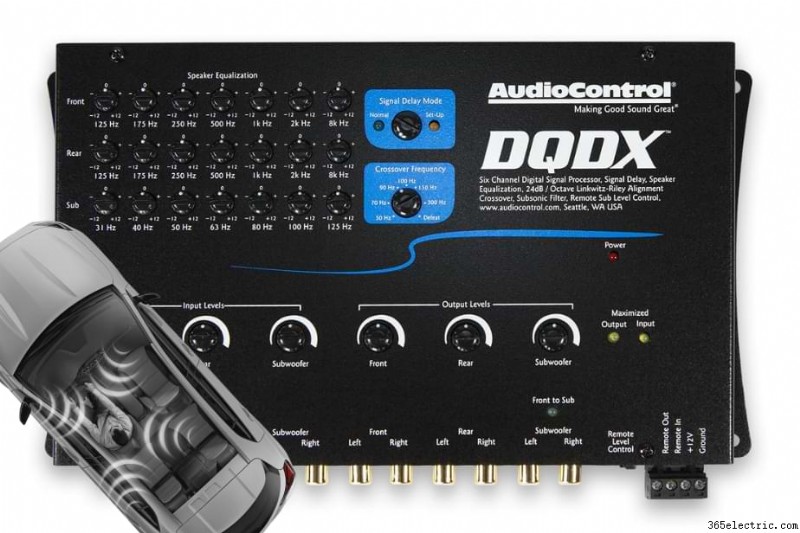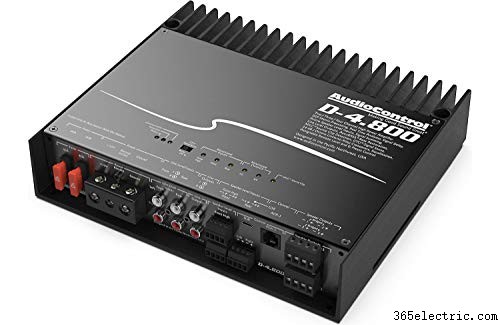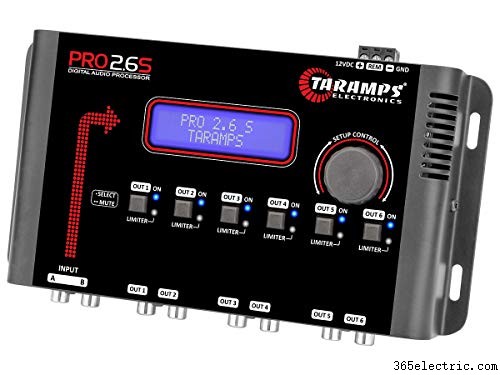Che cos'è il DSP nell'audio per auto? DSP vale il prezzo?
I processori di segnale digitale stanno diventando sempre più comuni nel mondo moderno dell'audio per auto. Queste unità sembrano essere vitali per tutti gli appassionati , ma sono in gran parte inutilizzati dalla maggior parte degli amanti della musica.
Molte auto moderne hanno un processore di segnale digitale integrato, ma molte no, e questo porta alla domanda:che cos'è effettivamente un DSP nell'autoradio?
Un DSP è un processore di segnale digitale che può essere installato nel sistema audio di qualsiasi auto. Un DSP consente un'incredibile quantità di controllo sul sistema e sul suo output. Fornisce tutto l'hardware necessario per far funzionare un sistema audio alle massime prestazioni e qualità.
Diamo un'occhiata più da vicino a che cos'è un DSP , indipendentemente dal fatto che tu ne abbia bisogno o meno, come impostare un DSP e quale DSP è il migliore per i soldi .
Ho bisogno di un DSP in My Car?
L'utilizzo di un DSP nella tua auto è un modo fantastico per ottenere il massimo dalla musica che ascolti, ma non è un requisito per un sistema audio per auto .
Alcuni sistemi audio per auto suonano benissimo da soli, con l'equalizzatore integrato nell'unità principale utilizzata nel sistema che è responsabile di tutte le modifiche audio e facendo il lavoro bene.

Il fatto che tu abbia bisogno o meno di un DSP nella tua auto dipende interamente dalle informazioni seguenti:
- come intendi usarlo
- la complessità del tuo sistema audio per auto
- quanto controllo desideri o necessiti sul tuo sistema
- il tuo budget
- quanto tempo e fatica sei disposto a dedicare alla ricerca, all'installazione e all'apprendimento dell'utilizzo di un DSP.
Potrebbe essere necessario un DSP per ottenere il meglio dal tuo sistema audio se l'unità principale installata nella tua auto non ha l'allineamento temporale .
L'allineamento temporale è un aspetto importante dell'autoradio perché l'abitacolo di un'auto non è lo spazio migliore per ascoltare la musica. A seconda della forma dell'auto, potresti sentire i suoni in modo diverso dal previsto.
I segnali audio devono essere inviati dagli altoparlanti al momento giusto per ottenere il meglio dalla traccia stereo utilizzata nella maggior parte delle registrazioni moderne.
Quasi tutte le registrazioni di brani moderni sono registrate in stereo o surround, ma questo effetto perso in un sistema audio senza un corretto allineamento temporale. Avere un DSP è il modo migliore per ottenere il massimo dai segnali audio trasmessi attraverso il sistema audio della tua auto.
Detto questo, il tuo sistema può suonare alla grande senza un DSP e avere un DSP si aggiunge solo al sistema che hai già. L'aggiunta di un DSP non farà suonare improvvisamente bene il tuo sistema. Solo offre un maggiore controllo sui segnali audio del sistema .
Quando utilizzare un DSP nell'audio per auto?
- Se disponi già di un buon sistema nella tua auto e desideri ottimizzarlo al massimo delle sue capacità ,
- Se hai il budget e il tempo per installare e imparare il sistema correttamente.
Quando non installare DSP nell'autoradio
- Se tutto ciò che stai cercando è un sistema audio chiaro e potente per la tua auto.
- Se non vuoi avere problemi con l'ottimizzazione di tutti i parametri del sistema.
- se hai intenzione di installare un sistema, impostarlo e lasciarlo
Un'opzione migliore per gli scenari di cui sopra è l'installazione di un buon equalizzatore.
Vale la pena DSP?
Quando trovi il sistema audio per auto perfetto per te, è importante considerare cosa esattamente vuoi ottenere dal sistema , piuttosto che acquistare solo i componenti più costosi che puoi permetterti.
L'installazione o meno di un DSP dipende interamente da come si desidera che suoni il sistema e dalla qualità della configurazione attuale .
Un DSP non farà mai suonare il tuo sistema meglio di quanto possa ottenere da solo in termini di prestazioni, uscita e potenza. Un DSP è progettato per consentire all'utente di regolare con precisione l'uscita di un particolare sistema audio piuttosto che migliorare drasticamente il modo in cui suona.
Se il tuo sistema è già costruito per la qualità audio che desideri, l'aggiunta di un DSP potrebbe valere la pena per mettere a punto e controllare con precisione il sistema hai installato.
Se alcuni aggiornamenti hardware migliorano la qualità del suono complessiva del sistema, l'aggiunta di un DSP potrebbe non valere la pena e lo sforzo , poiché non aggiungerà altro alla qualità del suono.
Un DSP ti consente di controllare con precisione l'uscita audio dell'intero sistema, fino all'esatto equalizzatore per ciascun altoparlante. Ciò ti consentirà di compensare le anomalie acustiche nell'auto, l'allineamento temporale e i ritardi tra ciascun altoparlante . Trae la migliore qualità audio stereo da un sistema.
Un DSP non farà suonare bene un sistema audio di bassa qualità, ma può aiutare a perfezionare un sistema già di alta qualità e renderlo il migliore possibile.
Se un DSP vale o meno dipende da quanto deve essere messo a punto il tuo sistema per suonare al meglio e non ne vale la pena se devi prima aggiornare il tuo sistema.
I processori DSP funzionano con le radio di fabbrica?
L'installazione di un DSP in un sistema audio per auto è un modo eccellente per migliorare e controllare il sistema .
La radio di fabbrica in molte auto moderne è integrata nell'interfaccia e nella navigazione del veicolo . Ciò significa che rimuovere la radio non è così semplice come lo era dieci anni fa. In molti casi, l'intera interfaccia utente e il sistema di navigazione dovranno essere modificati prima di installare un nuovo stereo.
La cosa buona è che la maggior parte delle autoradio moderne può ricevere un aggiornamento del processore di segnale digitale .
A DSP is usually hardwired into the system, meaning it does not rely on computer integration to function and can be installed with almost any standard factory car radio .
Installing a DSP with a factory radio is an excellent way to get the most out of the factory-installed radio without modifying the entire system when installing an aftermarket radio.
A DSP may be integrated into an audio system with a factory radio, providing greater control of the vehicle’s audio system .
Modern cars have radios installed that are compatible with almost all digital signal processors, but when working with older hardware, you will need to be sure that the components are compatible with one another .
It is possible to install a digital signal processor with almost every factory radio, as long as the components will work together .
How to Tune Car Audio DSP for the Best Sound?
Tuning a car audio DSP for the best sound is a complicated endeavor , and there are many ways and methods that can be used to adjust a DSP.
The most significant factor in tuning a car’s audio digital sound processor is the way it sounds. There are many technical and complicated variables, but if the audio in your system sounds good to you , then that is all you need.
When you are setting up the system, you do not have to follow the exact formula. If the process that you use to tune the DSP in your system varies from the settings used by your friend, do not worry. Remember that everyone has different requirements, and if your sound system sounds good to you, you have done well!
That being said, here is an elementary guide for tuning a car audio digital signal processor:
Set the DSP crossovers
The first step is to set the DSP crossovers . The key here is to try and aim for as flat a response from the crossovers as possible, allowing the system’s sound to be as close to reality as possible.
Set the crossovers at the same frequency between tweeter and mid-range, aiming as close to 24dB as possible .
Set the time alignment for each speaker
Next, set the time alignment for each speaker according to the position of your ears when you are sitting in the driver’s seat.
This is not the most straightforward process, but there are online speaker measurement calculators to make the process much less painful. The best calculator I have found is the TRACERITE . It is straightforward to use and makes excellent calculations.
Before start, you have to measure the distance from the speakers to the ears. Make measurements when you are in the driver’s seat and input the numbers for every speaker into a calculator.
The calculator will give you the time alignment figures to input into your DSP.
Apply the time alignment settings into the DSP, focusing the audio on your listening position .
The online calculators have a section that will allow you to shift the central focus of the audio if you want to move it to the middle of the car or to the passenger seat. Simply add the time delay on each speaker according to where you want the focus center to be.
Use EQ for further adjustments.
The next step in tuning the DSP in your car is to EQ the system . For this, it is best to use a pink-noise treatment method.
Play a pink-noise treatment track through each isolated speaker, taking measurements with the DSP to check for any peaking or clipping frequencies .
Cut the undesirable frequencies as you go. Repeat the process for all front speakers individually, then activate all front speakers and play the track again .
Do the same for the rear speakers and repeat the process with all of the speakers playing the track simultaneously.
Adjust the EQ according to what you are hearing, and remove any unpleasant frequencies in the DSP.
Integrate the subwoofer into the system by following the same processes, but EQ the sub according to the bass frequencies you want to hear , rather than balancing the sub with the rest of the speakers.
This is quite a simple process, and you can do this by simply listening to the sub and boosting or cutting the frequencies according to what you hear.
Listen to the entire system with the pink-noise track, and then play your favorite system testing song and make any adjustments that catch your ear .
This is a straightforward setup, and it is a good starting point to dial in the perfect sounding audio system according to your ears.
Should I Buy A Car Amplifier With Built-in DSP Or A Separate DSP Unit?
Digital signal processing has become much cheaper to install into amplifiers than analog signal processing and is simpler to install for amplifier manufacturers.
For these reasons, almost every modern amplifier has some sort of digital signal processor built-in as standard .
However, just because an amplifier has a DSP built-in, it does not mean that it is the best DSP or functions as a DSP. Many cheap modern amps use digital signal processors rather than analog components for ease of use and because they are more cost-effective, not because they improve the audio system .
For this reason, many people wonder if they should buy an amplifier with an integrated DSP or if they should buy an amplifier with no DSP at all and instead buy a separate DSP unit .
The answer comes down to your own personal needs and requirements and what you want the system to do .
If having the control of a DSP is important to you, but you want to save space in your car, and if you don’t mind using whatever DSP the amp manufacturer supplies, then it is worthwhile to buy a good amp with an excellent integrated DSP . In this case, you will probably end up spending the same money on a separate DSP unit later down the line anyway. The excellent amplifiers with built-in DSP are made by Audio Control . These products have exceptional quality and offer excellent performance.
I know Audio Control like for example D-4.800 is not the cheapest one, but if you want to make your car unique with an amazing hi-end system, you should not cut corners, but aim for the top class.

On the other hand, if you want maximum control over your car audio system’s performance, it is better to buy an amplifier and a DSP as separate units.
This setup allows you to choose the exact amplifier and the exact DSP that is best suited for your system and your requirements.
A separate amp and DSP may be more expensive and take up more space in your car, but this is the best way to achieve the highest level of audio quality from your car’s audio system .
How To Choose Best DSP Processor
The DSP you choose for your car audio system depends on the system you are building:
- Choose the DSP that you want to use, and build the system around the DSP, or
- Choose the rest of the system components you like and want to use, and then choose a DSP based on the system’s requirements .
The DSP you choose must be compatible with all system components, including the amplifier and the connection terminals .
After you have made sure that the DSP you are using is going to work with the rest of the system, then you must consider the actual functionality of the DSP .
There are thousands of DSP units available. The best one to use after making sure that it will work with your system will be based on the DSP features, the user interface, the EQ and crossover functionality , and the budget you have available.
Choose a DSP based on what it can do and how long it will last. Buy the most versatile and best-sounding DSP you can get your hands on that is also compatible with your system.
Which Is The Best Car Audio DSP For The Money?
There are so many DSP units available today that choosing the best value for money DSP can be tricky.
The best affordable DSP unit available at the moment is the Taramp’s Pro 2.6 S Digital Audio Processor .
This DSP works fantastic for what you pay for. It supports 10.2V peak-top-peak output (3.6 RMS voltage), 3-bad parametric EQ, 10Hz – 20 Hz frequency response, 2 channel input, 6 channel output; it is tiny and really light .

Conclusione
A car audio DSP can be a fantastic addition to a car audio system .
These units allow the best possible audio quality and control from an audio system and improve any car audio system’s fidelity and quality.
Using a DSP will not make an imperfect system sound good, but it will help a good system sound great!
DSP’s can be used with almost any car radio, integrated into any car audio system , and are easily available.
Installing a DSP can be difficult, and tuning it can be even harder , but if you install the right DSP in the right audio system, it will take the system to the next level!
Installing a DSP is highly recommended for anyone who cares passionately about the audio system in their car!
